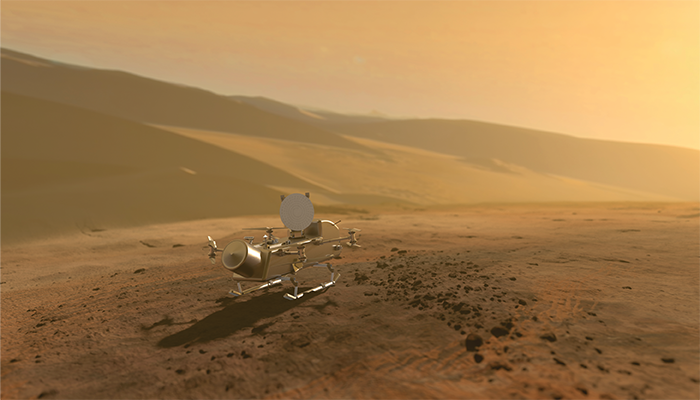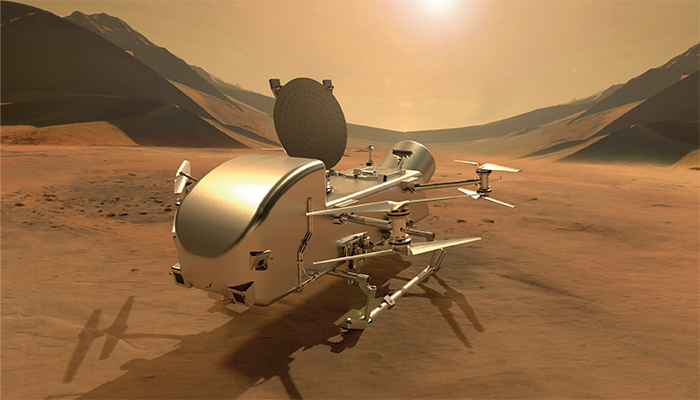Humans ask questions and take risks to find answers – from playing with fire to deep sea exploration. As technology continues to advance, we’re pushing ourselves further – even beyond Earth’s atmosphere to find out whether we’re alone in the universe.
As scientists set their sights on the moons of Saturn and Jupiter to find out whether they might harbor alien life, we’ll be speaking to the analytical scientists involved in developing the methods required to make the crucial measurements in far from ideal conditions.
To kick the series off, we speak with NASA Astrobiologist Melissa Trainer about the DraMS mission to Titan, and the prospects of detecting extraterrestrial life in our solar system.

How did you end up working in this field – what was it about analytical science that interested you?
I was a chemistry major in my undergraduate studies and gravitated towards instrumentation and designing experiments. By the time I reached my PhD, I was drawn in by atmospheric chemistry – specifically the types of measurements you can make and how analytical techniques help. I started my studies thinking about Earth’s atmosphere, but I happened to be working at the University of Colorado during the time it was partnered with the NASA Astrobiology Institute, which was exploring the multidisciplinary aspects of astrobiology. Being around these different studies and disciplines in the lab piqued my interest in Titan – Saturn’s largest moon – and the potential similarities with ancient environments on Earth.
This led me to where I am today: the Goddard Space Flight Centre at NASA, designing instruments to send to planets within our solar system to learn more about habitability, prebiotic chemistry, and the potential of extraterrestrial life.
Which moons do you think are the most likely candidates for extraterrestrial life in our solar system?
The first thing we need to establish when looking for extraterrestrial life is habitable environments that can sustain living organisms. For example, there is a lot of focus currently on ocean worlds – planets within our solar system that have a subsurface ocean may seem inhospitable on the surface, but the surface boundary could have properties that are able to sustain life. With moons like Europa, there’s high radiation hitting the surface alongside a thick, cold ice crust. However, underneath this crust is an ocean that’s interacting with interior core rock. This rock water ice boundary could be a steady habitat for life. There are other locations that could sustain properties for life, but we’re just breaching the precipice of possibilities for scanning the solar system for extraterrestrial life.
How do we currently look for extraterrestrial life – and are there any analytical challenges preventing progress?
Many people in the community think it’s really important to have imaging that allows us to observe and estimate motility. We need to think about how we’re interacting with the environment, whether we can sense chemical gradients, the possibility of using molecular measurements to find DNA in a sample, and so on.
To conduct so many different variations of analysis, we need to ensure the design of our system can handle the payload without collecting false positive data. The engineering challenges for these projects are complex – we need systems that can take detailed measurements with intricate images. Though this requires incredible power, there also needs to be a sterilizing system to ensure samples aren’t contaminated or degrade past the point of usefulness. There’s an incredible number of aspects to think about, and that’s where I see a lot of our analytical challenges culminating.

Could you give us an overview of some of the analytical technologies employed in this line of research?
Mass spectrometry continues to play an important role in these investigations. Because it’s a generalized technique, you’re able to look at the chemical content of an environment, look at potential molecular bio signatures, and explore the proteins and DNA of a cell.
There’s also plenty of uses for microscopy in this field. As a visual society, we find it easier to use the analogy of seeing is believing – viewing the minute details provides an important contribution to this study of life. Through microscopy we can also use powerful selective analysis for different types of biomarkers – using DNA sequencing as a complement to mass spec gives us the potential to zone in on specific polymers.
Environmental sensors can also be useful for looking at gradients and potential interactions with the environment. Such sensors allow us to monitor the local area and learn how nutrients are moving in and out. I see this as an incredibly important part of the science, but the question is: How do we do this analytically? There are plenty of analytical techniques available, but these stand out as some of the most commonly used in current practices.
Tell me about Dragonfly…
Dragonfly is a mission to Titan – due to launch in 2027. It is a chemistry mission, as opposed to a life detection mission, which is a very important distinction. What we really want to look at is Titan’s potential for prebiotic chemistry.
Dragonfly is a quadcopter that carries a robust scientific payload, including the Dragonfly Mass Spectrometer (DraMS). Onboard Dragonfly, DraMS can be moved from location to location across Titan’s surface to investigate the different environments. And that allows us to sample organic sands that have formed dunes, and look at the chemical composition of the ice crust. We can also go to a place where there was an impact melt in the past. By drilling into these spots, we can see the composition of trace molecules dissolved in liquid water before it truly froze over – providing us with evidence of really advanced chemical synthesis.
The system also uses a gamma ray spectrometer (GRS), which maps the chemical elements on the moon’s surface. It measures how neutrons emitted by the spacecraft interact with different surface materials to determine the amounts and types of elements present.
Ultimately, we’re hoping to understand what kind of molecules are present in an environment that has varying similarities and differences to what we understand is important in sustaining life on Earth.
What challenges did you face while creating DraMS?
Working with Titan’s thermal environment in particular presents various challenges. Titan’s surface temperature is extremely cold at 94 Kelvin (-189 Degree Celsius) – most instruments and mechanisms won’t function in this atmosphere. Because of this, we’ve added thick insulation around Dragonfly and used an MMRTG (multi-mission radioisotope thermoelectric generator) as the power source. This allows us to trap waste heat inside and circulate it to keep Dragonfly at an operating temperature. The MMRTG power source can also charge its battery on Titan’s surface, allowing us to work here for multiple years.
Another issue with the atmosphere of Titan is in the process of taking samples. We have to be able to store different samples within Dragonfly in a way that doesn’t alter their temperature or integrity. By trying to keep Dragonfly warm, we could cause damage to samples taken from the surface. This meant we couldn’t totally insulate the entire rover, so we’ve ended up with this medium stage that keeps the storage area cold even while being in close proximity to the power and heat source. Thermal management has definitely caused us some headaches.

Are there any similar missions planned for the future?
Next year, NASA is hoping to launch the Europa Clipper mission, which is a Jupiter orbiter that will complete flybys of Europa to learn more about the chemical environment – feeding our understanding of the likeliness of finding life in the moon’s interior ocean. This will be a five-year project, and there will ultimately need to be further missions that allow us to land on Europa to sample the ice. But this is a long way into the future – we need more technological advancements to take these steps to get through the ice press and get into the ocean.
NASA’s New Frontier proposals are coming up within the next few years, and I’m expecting some missions to be focused on Enceladus – another of Saturn’s moons. Icy moons in general are extremely exciting locations for evidence of habitability and potential signs of life. We can also see some similarities between Enceladus and Europa – they both have active interior oceans – so in the future I expect several mission concepts for going through the water plumes of these moons and capturing fresh samples, or even landing on the surface.
Could you speak to the importance of collaboration in this line of work?
One thing I love about planetary science is how interdisciplinary it is. It’s impossible to do what we’re doing without having input from a large number of people across a range of disciplines – the DraMS project is a perfect example of this. There are those of us who are trained in chemistry, looking at the molecules within the planetary environment, physicists to figure out how we can get across the solar system to reach Titan, nuclear scientists to create the GRS instrumentation used within Dragonfly, thermal engineers to ensure the project survives in extreme temperatures, geologists and oceanographers to interpret observations from the spacecraft once they arrive at target destinations… I could go on and on.
What most excites you about working in this area?
Overcoming the challenges really excites me, even if this does make my job a lot harder. I could easily analyze a sample with an instrument by going down the hall in the lab – but doing this autonomously on a moon in space has all these weird environmental features that require a lot of problem solving and difficult choices.
I’ve spent years and years in the lab trying to guess what the organics on Titan are made of – and now we’re going to be able to actually measure them. That’s a huge breakthrough and I’m very excited about it. From seeing the images and measurements from the touchdown of Dragonfly on Titan, we’re going to completely rewrite everything we thought we knew – and that’s what makes planetary exploration so fun. We can design the most robust system, make lots of predictions and nice graphs, but we really have no idea what it’ll be like until we get there. We want to be proven wrong because it’s what makes discoveries all the more exciting.
Finally, if you were a betting person, how confident would you be putting money on extraterrestrial life in our solar system?
I would probably be comfortable placing a bet that there is life beyond Earth, but I don’t think that I will be around to see it firsthand. As time goes on and technology improves, the odds increase. I don’t think it will happen within my lifetime, but I would love to be proven wrong!




